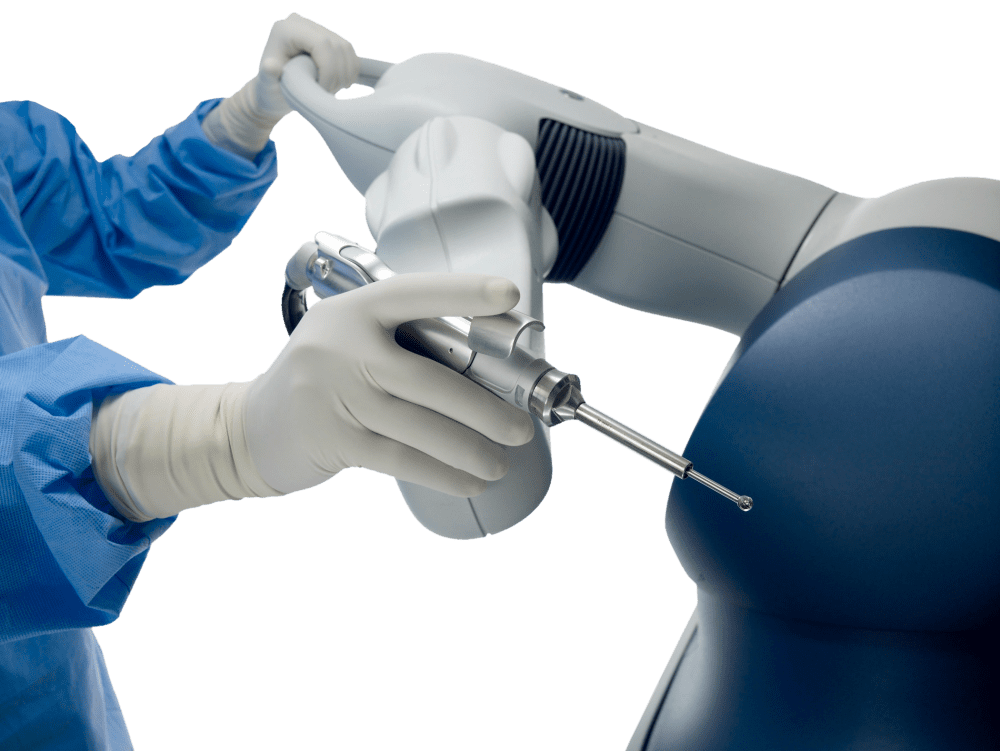
Robot-Assisted Surgery for Partial and Total Knee Replacement

Whether you blew out your knee in a rough game of rugby or you’re suffering from the effects of osteoarthritis, you know that knee pain can stop you from doing everything you love. If conservative treatments, such as lifestyle changes, physical therapy, and medications, haven’t worked for you, your doctor may recommend partial or total knee-replacement surgery.
If you’re in need of a new knee, make sure to do your homework and choose the right surgeon and the right surgery for you. Every doctor approaches patients and treatments differently, so check into your physician’s credentials, treatment philosophy, success rate, areas of expertise, advanced technology capabilities, and even their bedside manner.
Like so many people in the Greater Chicago area, you’ll likely zero in on Vasili Karas, MD, at Chicago Orthopaedics & Sports Medicine. Dr. Karas, a native Chicagoan, is known for his uncommon commitment to total patient care, including taking the time to get to know you and understand your unique medical concerns.
Above all, he’s an expert in the latest robotic joint-replacement technology and can promise you the most successful, least painful experience possible.
Do you need partial or total knee replacement?
Before you consent to knee surgery of any kind, it’s important to know your options. To avoid joining the long list of people who have received total knee replacements when all they really needed was a partial replacement, here’s what you need to know.
Your knee joint has three compartments: medial (inside), lateral (outside), and patellofemoral (front). If your injury or arthritis has damaged only one of those compartments, you may need only a partial knee replacement — which is less invasive, less painful, less expensive, and less debilitating.
Of course, if the damage to your knee has progressed to all three compartments, you will likely need to have the whole knee joint replaced. Countless patients trust Dr. Karas to make the most accurate and conservative recommendations when it comes to their unique health concerns and lifestyle goals. Dr. Karas always strives to preserve your healthy bones and tissue whenever possible.
Traditional vs. robot-assisted surgery
All knee surgeries are not equal. Once you know you’re a candidate for knee-replacement surgery, chances are, you’ll hear stories of long and painful recoveries.
That’s because the traditional procedure requires a long incision (usually about 6-10 inches) so the doctor can move your kneecap out of the way and remove damaged surfaces. Partial knee-replacement surgery, though less invasive, still requires precision and finesse for proper recovery.
The conventional technique starts with an X-ray image of your knee to help the surgeon determine which areas of your joint to remove and where to place the new parts. During the procedure, the surgeon must rely on the visual assessment of your joint and manual dexterity to get it right.
Keep in mind: Getting it right isn’t easy. If your surgeon is off by even a millimeter or two, the replacements parts won’t fit perfectly, inviting pain, uneven wear patterns, and eventually, the need for more surgery.
With robot-assisted surgery, Dr. Karas uses a CT scan to make a virtual 3D model of your knee, enabling him to establish a much more accurate preoperative plan. During surgery, he guides the robotic arm to ensure accurate incisions, exact resurfacing, and precise positioning of replacement parts.
The robotic arm uses computer navigation to make sure all of your new parts are aligned and working smoothly, and it prevents the surgeon from making cuts or changing surfaces beyond the predetermined scope. Dr. Karas then verifies the functionality of your joint before closing the surgery by bending your knee and checking for problems.
Benefits of robot-assisted knee replacement surgery
Studies show that robot-assisted knee replacement surgery results in:
- Less postoperative pain
- Faster recovery time (weeks instead of months)
- Less blood loss during surgery
- Less scarring
- Better long-term results with more mobility
When you’re ready to explore your knee replacement options and want to learn more about robot-assisted surgery, call our office or use our online scheduling tool.
You Might Also Enjoy...


Outpatient Physical Therapy In the Home – Getting Your Recovery Process Started in the Comfort of Yo

Robotics in Arthroplasty

Why Physical Therapy Is Key to a Successful Joint Replacement

Signs Your Joint Pain Might Be Serious


